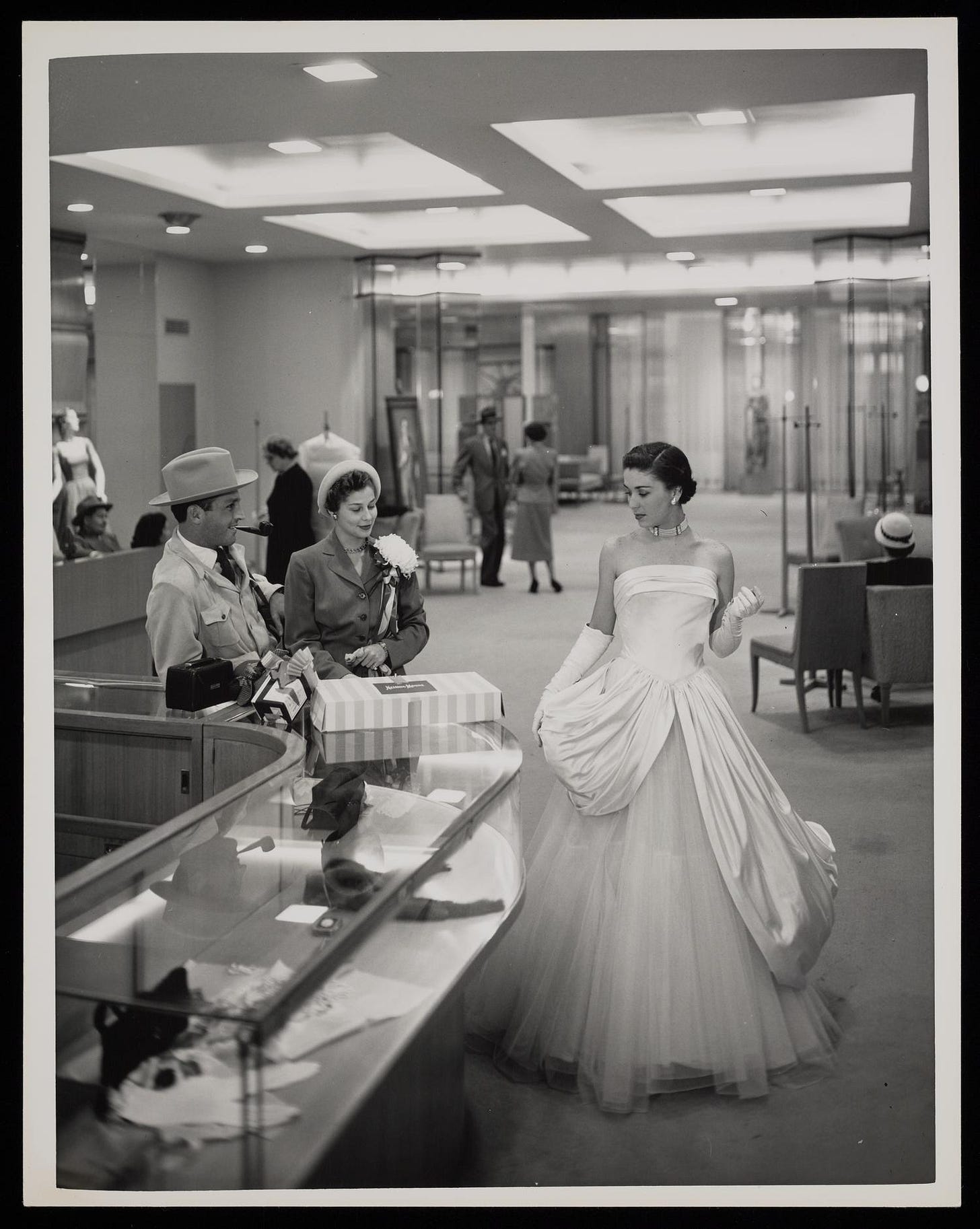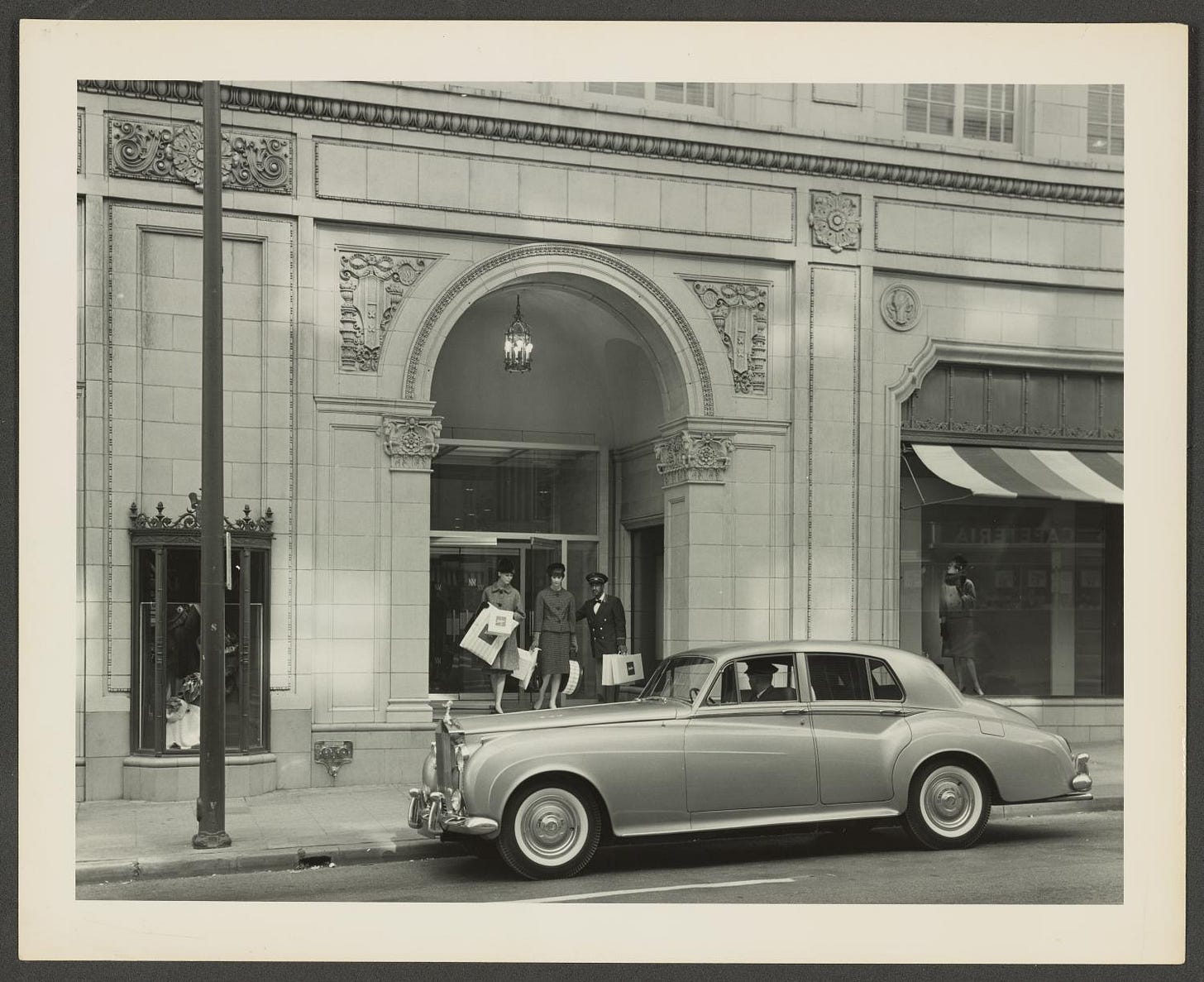Earlier this week it was announced that Neiman Marcus would close its flagship downtown Dallas store on March 31st. For department store aficionados (I saw one journalist describe us as “department store junkies”) and for many Texans, the Neiman Marcus on Dallas’ Main Street is a legendary store—built in 1914 after the previous location burnt down, the Renaissance revival building has inspired shoppers for 110 years.

This closure isn’t due to the poor performance issues that have plagued the department store industry; even though Dallas retail is mainly concentrated in malls (one of the few places in America where they still reign supreme), the Neiman Marcus flagship continues to draw in the crowds. According to an internal memo sent Tuesday to employees by Saks Global Operating Group CEO Marc Metrick acquired by the Dallas Morning News, “From as early as 2011 and as recently as December 2024, there have been several attempts to come to a commercially reasonable agreement with this landlord. All of these attempts have been rejected by the landlord who has now terminated our occupancy.” There is some confusion about who the landlord is—Bethany Erickson of D Magazine uncovered that Dallas Central Appraisal District records list the building as owned by the Neiman Marcus Group (a holding company that also owns Bergdorf Goodman). The Group filed for Chapter 11 bankruptcy in 2020; by 2022, Neiman Marcus Group was owned by a consortium of investment firms. This past December, Saks Global acquired the Neiman Marcus Group for $2.7B—while I would assume this would make Saks Global the owner of all Neiman Marcus Group real estate, there has been no confirmation or denial of this.

I’ve never been to the Neiman Marcus flagship (on my sole trip to Dallas I was incapacitated after a car accident meaning no fun excursions for me), so my understanding of it is the mythic, not the personal—how it has been represented in books, movies, magazines, advertisements, and oral histories. Previously in this newsletter, it has come up within discussions of Christmas catalogues and a documentary. When filmmaker Frederick Wiseman decided to make a documentary on shopping within American consumer culture, there was no other choice for him. As I wrote before, Wiseman chose Neiman Marcus as he felt that, in the words of NY Times writer Glenn Rifkin, “in many people’s minds it represents the store, the most famous emporium in the country and perhaps the world.” Wiseman’s 1983 film took that as its title—The Store—capturing the public and private sides of the business, the intricate merchandising and planning behind the scenes, and the extravagance of the oil-rich clientele in their natural habitat.
"The founders of Neiman Marcus first considered investing in Atlanta’s upstart Coca-Cola Co. before deciding to open a specialty store in downtown Dallas in 1907, according to family lore. The shop—opened by Herbert Marcus, his sister Carrie Marcus Neiman, and her husband, A.L. Neiman—proved to be a hit with the Dallas elite, who were flush with new oil money and eager to show it off. With a knack for luxury, Neiman Marcus delivered finery not found elsewhere and assurance against fashion faux pas. The upscale department store eventually expanded to cities across the country, its extravagance underscored in the annual Christmas Book. Though you may not be shopping for matching his-and-her sable coats or one of the catalog’s “fantasy” gifts—last year’s highlight was a limited-edition Aston Martin—you can still get into the holiday spirit at Neiman Marcus’ flagship store, located at the corner of Main and Ervay streets. The shop’s whimsical holiday window displays have been a Dallas tradition for decades." —Traces of Texas
Thinking about this closure within the broader department store and retail industry, a few things come to mind. First, the importance of either owning the building (as Macy’s does with its Herald Square flagship) or having a landlord who will always work with you (the Bloomingdale’s flagship is still owned by the Bloomingdale family, not by Bloomingdale’s owner Macy’s). While I won’t pretend to know anything about real estate in downtown Dallas, from keeping track of former department stores worldwide there are several futures available to them: sitting vacant for many years, redevelopment into luxury condos, or redevelopment into offices (the midtown Manhattan Lord & Taylor flagship now houses Amazon), while small town department stores often seem to become antiques malls. From the comments on a D Magazine Instagram post, locals are betting on luxe condominiums.

Though they are for different reasons, Neiman Marcus’s closing has me thinking of the imminent closure of Macy’s store in downtown Brooklyn. Located within the historic Abraham & Straus flagship (built in 1883), this Macy’s, for as long as I’ve frequented it, has been a pretty dismal affair. I should probably write “tried to frequent it”—though I’ve lived quite close, walked by often, and am eager to visit historic stores, it was plagued by low stock and few salespeople—quickly ringing up one item always felt like an impossibility. This Macy’s, as with so many other department stores, has taken the approach of hiding all original detailing—columns boxed in, drop ceilings installed—the effect no longer grand but depressing and dark (this was particularly notable in the Art Deco Sears Roebuck & Company Flatbush Brooklyn location that closed in 2021). Macy’s is closing 65 stores nationwide this year, including Philadelphia’s grand former Wanamaker’s in Center City (immortalized on film in Mannequin) as part of their “Bold New Chapter” strategy.

Whether from poor performance or landlord issues, the widespread closure of department stores is a loss for communities and of history. Social media is currently filled with people reminiscing about memorable times at Neiman Marcus downtown—weekly trips with grandparents, meeting Santa, running into retailing legend Stanley Marcus, browsing during lunchbreak, tea at the Zodiac Room (more on that this weekend). It was an institution. The Dallas Morning News editorial from February 19, 2024, speaks to what its loss means for the city:
Neiman’s is tied to so many memories of the city. As downtown has had its ups and downs, Neiman’s has been there, a tradition that people could rely on, a place where the generations could share stories of years gone by and look forward to years to come. The Neiman Marcus company was formed in 1907 and through the middle of the 20th century came to define something about Dallas itself.
To the outsider or the cynic, it was a kind of new money striving for outlandish luxury and high-priced style as a substitute for deep-rooted social standing. If the assessment stung, it was because it had a lot of truth in it: Dallas’ newly rich needed a place to spend the oil money that flowed into the city like a gusher.
But time has weathered the trope and softened it into something more durable. If Neiman’s was once a symbol of a flush boomtown, it has become a standard of something that is increasingly lost on us in today’s America. Its brand has become a kind of insistence on tradition and a sense of beauty that marks moments in our lives as special and worth celebrating or dignifying in our dress and manner…
Then, as now, buying something at Neiman’s anchor store in downtown Dallas was a reach for many of those who walked past its ornate exterior and gazed into its beautifully adorned windows.
Dallas has always been, from its beginning, a city filled with people hoping to make it, with a little luck and a lot of work. And Neiman’s was there, an embodiment of making it, of a city on the rise, a city that wanted to be among the great cities of the nation.
To lose that is to lose something of who we are and who we want to be, whatever people may think of us. And, in our home in Dallas, it hurts.

So much of what made Neiman Marcus the embodiment of Dallas’ rise was due to Stanley Marcus, son and nephew of the founders who was president (1950–1972) and later chairman of the board (1972–1976). As the Advertising Hall of Fame noted, "Stanley Marcus was among the most important figures in the history of American retail merchandising and marketing. Through his many innovations, he transformed a local Dallas clothing store into an international brand synonymous with high style, fashion and gracious service." Marcus created the Neiman-Marcus Christmas Catalogue, established the Neiman Marcus Award for Distinguished Service in the Field of Fashion, and made the store into a locus of activity with art exhibitions, weekly fashion shows, and the annual Fortnight event (a trade fair that celebrated a different foreign country or region, similar to Bloomingdale’s internationals fairs). He was known for his personal warmth and the warmth he brought to the store; a 1955 Cosmopolitan profile describes how the “store's fifty-year-old president, Stanley Marcus, likes to operate in the lighthearted atmosphere which pervades the selling floors, the promotions by mail, and the advertising. Employees stay with the store because of the unusual satisfactions in working there.” As an art collector, he brought modern art directly into the store; one article from 1957 recorded how “in the Dallas store a pair of murals by Vertès and a rug by Miró are only casual decorations”—thereby elevating the taste not just of the shop but of the burgeoning city.

“Like Florence in the heyday of the Renaissance, [Dallas] has been shaped by ‘merchant princes.’ Outstanding among these is, currently, Stanley Marcus, whose great specialty shop, Neiman-Marcus, proved that Dallas could be as good as anywhere else and provided the city with a sort of contagion of excellence.” – GQ, March 1966

I’ll finish this rush of thoughts with some words from Stanley Marcus on the Neiman-Marcus difference, from his autobiography Minding the Store:
Very frequently I am asked, "Why is Neiman-Marcus so different from other stores? What is the mystique of Neiman-Marcus?" The best answer I can give is that stores are, in a way, similar to newspapers, which all have access to the same news sources. They subscribe to the same domestic and foreign wire services, and while some may have more reporters in various parts of the world than others, they all use approximately the same grade of newsprint and similar types of presses. The quality that makes one paper stand out like the New York Times and another like the New York Daily News lies in the editing. One paper features its foreign news on the front page, the other buries it in condensed form inside; one plays up violence in its headlines, the other relegates such stories to its local news section. So it goes with stores. Essentially, all of us buy in the same market, but we select differently. One store may buy the most flamboyant costumes from a well-known designer, the other will pick out more subtle clothes. One store may depend completely on the domestic market, others search out the best from all over the world. A customer of ours once described what she discerned as the difference between our store and others when she said, "What I like about your store is what it doesn't have. I don't have to wade through dozens of articles to find what I want." She was complimenting our selectivity, another word for editing. This process starts with the head of the store, who must lay down certain guidelines as to standards of taste and quality for which he wants his store to stand.
So much of what current department stores are lacking are those “standards of taste and quality,” the personal touch, and the understanding of shopping as an experience that Stanley Marcus so clearly recognized.

Frederick Wiseman's The Store
Frederick Wiseman’s The Store (1983) is a documentary, hence my not including it in my Christmas movie round-up, yet somehow it perfectly captures the season for me. During the four weeks between Thanksgiving and Christmas 1982, Wiseman was turned loose in Neiman Marcus’ flagship and offices in Dallas, filming both the public and private sides of the business.
Catalogs > Gift Guides
From being the purview of print magazines to the domain of online publications, and now within the scope of every newsletter writer and brand, gift guides are everywhere. Now that everyone writes a gift guide, it feels like the art of curating an interesting selection of presents is more a competition to show off someone’s taste and wealth or merely a b…







For the first time in literally years I visited the NYC Bloomingdales in hopes of finding … gloves. Shocking mistake. I’ve been under a rock, true, because I try not to buy anything I don’t need. Not on the internets, not in a brick and mortar emporium. But it was my daughter’s birthday and she wanted/needed gloves. When did Bloomies turn into a mall of luxury boutiques? Floor after floor of designer tat… no gloves. Of course no socks… also wanted to score some quality knee socks (it is to laugh). I repaired to Macys. I know it a little from going to the Clinique booth, looking for ties. It’s big and confusing but it’s still something of a department store. One stop shopping!? I was unable by myself to find a glove section but I figured the underwear floor might have socks. They did though only one sad pair of knee socks. While I was there I picked up a bra. I found a salesperson. The salesperson wrapped my bra in tissue. I cried! She even knew where I might find gloves. I showered her with praise (she was old like me). I feel like I had one last encounter with the divine.